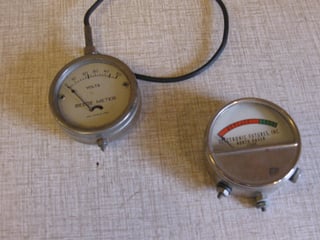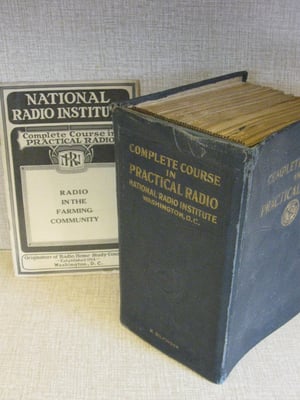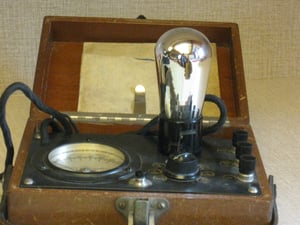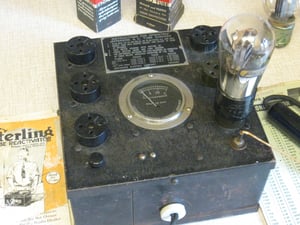Vintage Audio: 1920s Radio Workshop | Telos Alliance
By The Telos Alliance Team on Apr 26, 2016 11:30:00 PM
 Vintage Audio: 1920s Radio Workshop
Vintage Audio: 1920s Radio Workshop
As electronics technology has evolved over the years, so has the equipment used to service it. Today, electronics is largely a software game, where DSP chips take the place of tuned RF circuits, and even complete receivers. These devices operate with specs near theoretical perfection. As a result, the workbench is no longer the nerve center of an engineering shop in the way that it once was.
The electronics workbench had its origins around the same time as radio, in the mid-1920s. Those old TRF sets could be unreliable, and anyone who sold radios as a business also installed and serviced them. This installment of Found in the Attic is a bit different. We'll dig out several items that were essential for radio servicing in the 1920s, as we imagine what types of things were on the electronics workbench almost 100 years ago.
At its most basic, troubleshooting starts with measurements of voltage, resistance, and current. Those numbers are then compared to schematics to determine what is normal and what is not. Long before Vacuum Tube Voltmeters (VTVMs) or even Volt-Ohm Milliammeters (VOMs) were around, those measurements were done with pocket-watch-style voltmeters. These devices were first developed in the 1890s, as batteries were beginning to be commercially produced. They became the industry standard for both radio and automotive servicing in the 1920s and '30s. Most had a nickel-plated bass case and were styled to look like a pocket watch.
They were typically used to measure the plate and grid voltages on radios, and had both 0-12 (grid) and 0-120 (plate) scales. The case was usually connected to ground, while a short lead was connected to positive. Occasionally, the rubber insulation between the meter movement and ground would break down, resulting in a nasty surprise for the radio serviceman. Some meters could measure both voltage and current, using different terminals on the bottom of the device.
Nothing is known about the application of the Electronic Futures 'replace-good' meter, although the company remained in business in North Haven, CT at least into the late 1960s.  Some of the more common brands of pocket watch meters were Sterling, Readrite, and Eveready.
Some of the more common brands of pocket watch meters were Sterling, Readrite, and Eveready.
The use of several pocket watch meters for servicing must have been cumbersome. Devices eventually appeared with one meter having multiple scales in a bakelite case. Connections were made to the meter via several pin jacks and multiplier resistors. Eventually, those pin jacks were replaced by a rotary switch, and the VOM as we know it came into being.
While many of us got at least some of our education about radio and electronics by hanging around with old-timers, the aspiring radio serviceman of the 1920s didn't have that option – there were no old timers. Still, the radio industry needed lots of qualified repairmen in a hurry, and it was a lucrative career option at the time. Those living in or near urban areas could attend a traditional trade school, with classroom and laboratory instruction. The vast majority of those living in small towns or rural areas however had to find other paths to radio education.
To learn about radio servicing, and many other subjects, instruction via correspondence school was the way to go. The format for correspondence school instruction was pretty much the same regardless of the subject. Students were assigned an instructor, who was responsible for grading exams, answering difficult questions, and generally providing the motivation necessary to help the student stick with what could be a long series of lessons until the program was complete.
Lessons and exams were mailed to the student, who studied the material, completed the exams and mailed them back for grading. The lessons were usually saved in a binder, and served as a reference at the completion of the course. At the end, of course, you got your diploma in the mail.
For radio servicing, instruction from the National Radio Institute (NRI) was a very popular choice. NRI was founded in 1914, by high school instructor James E. Smith, in Washington, DC. In 1968, the school was purchased by McGraw-Hill Education, and renamed NRI Schools, McGraw-Hill Continuing Education Center. Smith stayed on as NRI's chairman until his death in 1973, and was succeeded by his son, J. Morrison Smith, who retired in 1976. Ads for the NRI school were a regular feature of hobbyist magazines such as Popular Electronics, Electronics Illustrated, and Radio Electronics.
 Electronic media changed the nature of correspondence schools, and many, including NRI, adopted audio cassettes and VHS video tapes into their curriculum. The coming of online instruction via the Internet spelled the end for most correspondence schools. In 1999, citing 'changes in the marketplace', McGraw-Hill announced plans to phase out the NRI school. It ceased operations in March of 2002.
Electronic media changed the nature of correspondence schools, and many, including NRI, adopted audio cassettes and VHS video tapes into their curriculum. The coming of online instruction via the Internet spelled the end for most correspondence schools. In 1999, citing 'changes in the marketplace', McGraw-Hill announced plans to phase out the NRI school. It ceased operations in March of 2002.
The pictured course book is from 1927, and we see that today's lesson is all about radio in the farming community, the subject of an earlier Found in the Attic. The NRI link in this article gives complete access to the contents of a very similar 1930 radio course preserved on the American Radio History website.
Those early vacuum tubes had a short life by later standards, and a means of testing soon became necessary, even though substitution with a new tube was always an option. Pictured are two tube testers from the 1920s. The one in a wooden case was manufactured by the Victor Talking Machine Company (later known as RCA), and it is really a multi tester. The test set plug of this model E.M.-452-D was inserted in one of the set's tube sockets, while tubes remained in the others. 'A' (filament), 'B' (plate) and 'C' (bias) voltages could then be read using the rotary switch. Plate current could also be checked. Meter polarity could be reversed via a push button switch. The meter has a 7 and 140 volt scales. By inserting the test plug in each of the sockets, correct voltages could be confirmed for each tube.
With the test plug in one of the radio's sockets, tubes could be inserted into the 452-D and checked. Since there was only one tu be available at the time, the 201, this was a simple procedure. The meter could also be connected to binding posts for other tests.
be available at the time, the 201, this was a simple procedure. The meter could also be connected to binding posts for other tests.
The other tester is a Jefferson AC tube checker. It came along somewhat later, as it can test six types of tubes – 224, 226, 245, 227, 171A and 80. It conducts a simple emissions test, but cannot check for gas, leaks or shorts.
All of these items came from a college physics department. An alumnus had passed away in the 1970s and donated the contents of this radio workshop to his alma mater. For want of a better place, it all ended up in the electronics equipment room. The department was more than happy to give it to a young collector, and gain the shelf space for more practical items like oscilloscopes and spectrum analyzers. There are several other interesting items from the same collection, which for the moment, are lost in the attic.
Telos Alliance has led the audio industry’s innovation in Broadcast Audio, Digital Mixing & Mastering, Audio Processors & Compression, Broadcast Mixing Consoles, Audio Interfaces, AoIP & VoIP for over three decades. The Telos Alliance family of products include Telos® Systems, Omnia® Audio, Axia® Audio, Linear Acoustic®, 25-Seven® Systems, Minnetonka™ Audio and Jünger Audio. Covering all ranges of Audio Applications for Radio & Television from Telos Infinity IP Intercom Systems, Jünger Audio AIXpressor Audio Processor, Omnia 11 Radio Processors, Axia Networked Quasar Broadcast Mixing Consoles and Linear Acoustic AMS Audio Quality Loudness Monitoring and 25-Seven TVC-15 Watermark Analyzer & Monitor. Telos Alliance offers audio solutions for any and every Radio, Television, Live Events, Podcast & Live Streaming Studio With Telos Alliance “Broadcast Without Limits.”
More Topics: Vintage Radio Technology
Recent Posts
Subscribe
If you love broadcast audio, you'll love Telos Alliance's newsletter. Get it delivered to your inbox by subscribing below!